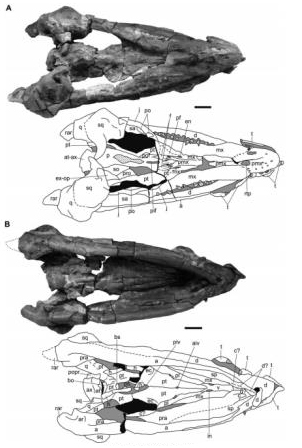New Giant Pliosaur From the Early Cretaceous of Colombia
Sachicasaurus vitae – Brings a Whole Town to Life
A team of scientists from the Universidad Nacional de Colombia (Colombia), have announced the discovery of a new species of giant brachauchenine pliosaurid from Lower Cretaceous-aged beds in central Colombia. The monster marine reptile, estimated to have measured around ten metres in length has been named Sachicasaurus vitae and is the largest of the three pliosaurid genera discovered to date from Colombian sediments.
Ironically, the species epithet for this formidable predator is Latin for “life”, a reference to the huge impact this discovery has had on the village of Sáchica where the fossil was found. It seems that the normally quiet village has had a considerable upsurge in visitors and commercial trade as the excavations of the huge specimen progressed.
A Photograph of the Holotype Specimen and Accompanying Line Drawing
Picture credit: Universidad Nacional de Colombia
The photograph (above), shows a dorsal view of the holotype (MP111209-1). The dotted lines represent parts of the skeleton found separate from the main body fossil deposit. The scale bar located below the photograph of the fossil indicates fifty centimetres. The skull is more than two metres long. The fossils come from Lower Cretaceous deposits located at Sáchica (the genus name honours the village).
Partially Articulated Specimen and Still Growing
The specimen was discovered in an articulated state and is estimated to have been around 9.9 metres long, but the researchers have concluded that the fossil remains represent a sub-adult animal so the maximum size for this marine reptile is unknown. Pliosaurs are an extinct clade of short-necked plesiosaurs that were both temporally and geographically widespread. Many pliosaurs were apex predators within Jurassic and Early Cretaceous marine environments.
Sachicasaurus Jaw Bones and Associated Teeth
Picture credit: Universidad Nacional de Colombia
The Most Complete Pliosaur Discovered in Columbia
Sachicasaurus vitae represents the most complete pliosaurid fossil specimen found to date in Colombia, it is also the largest pliosaur known from this part of the world. It lived approximately 125 million years ago (Barremian faunal stage of the Early Cretaceous). For such a large animal the front flippers seem particularly small, this suggests that it might have had a different form of propulsion, perhaps being more reliant on the rear flippers and powerful strokes of its tail (assuming the presence of tail fluke). Although the phylogeny of this marine reptile is uncertain, as it possessed a mix of primitive and more advanced anatomical traits, it has been placed within the Brachaucheninae and it may have been closely related to Kronosaurus.
An Illustration of a Typical Pliosaur Marine Reptile
Picture credit: Everything Dinosaur
The Powerful Skull of Sachicasaurus vitae
Picture credit: Universidad Nacional de Colombia
The Diversity of Coumbian Pliosaurids in the Early Cretaceous
The discovery of S. vitae highlights the diversity of pliosaurs known from the Early Cretaceous of Colombia. Two other pliosaurs have been recorded from this part of South America, both of which are smaller than Sachicasaurus. The occurrence of different genera of pliosaurids in the Barremian beds of Colombian suggests that the environmental conditions of the Colombian sea during the Early Cretaceous facilitated the development of sufficient marine life to sustain a diverse group of predators.
The other pliosaurs known from the Early Cretaceous of Colombia:
- Stenorhynchosaurus (S. munozi) named in 2016. It had a more elongated snout and may have been a specialised piscivore.
- Acostasaurus (A. pavachoquensis) named in 2017. It had a robust snout but was approximately half the size of Sachicasaurus.
Visit the award-winning Everything Dinosaur website: Everything Dinosaur.







